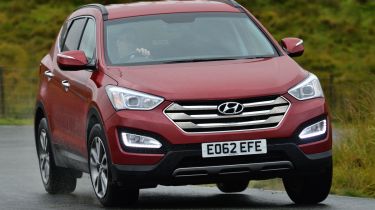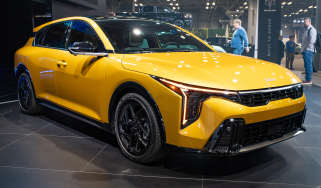Hyundai Santa Fe
It’s the largest car on test, but will that be enough?
You can tell that the Hyundai was designed as a seven-seater. While it’s a handful on narrow roads due to its imposing size, the stability and comfort on offer impressed. It doesn’t have the Mazda’s impressive handling, but the quality interior and long warranty make it a sound buy.
We expected big things of the new Hyundai Santa Fe, and so far it hasn’t disappointed. The seven-seater version won on its debut, but now we’re testing the cheaper five-seater against some tough opposition.
From the outside, it’s clear that the Hyundai was designed for space. Even in five-seat form, it’s 120mm longer and 60mm wider than the Honda CR-V. As a result, the Santa Fe appears more imposing on the road. The wide chrome grille and huge foglights add to this impression, while metal skid plates and twin exhausts make it look more suited to rough terrain.
It feels more utilitarian inside, too, with leather seat facings rather than full trim and manual adjustment for the front seats. Still, there’s no shortage of soft plastics and the touchscreen is the easiest to use here thanks to its bright, clear icons and intuitive layout.
Unlike in the Honda, activating Bluetooth or syncing your iPod takes only a few seconds and the sat-nav is also much simpler to read than the CR-V’s. But there are some niggles.
Used - available now

2023 Hyundai
Santa FE
18,730 milesAutomaticPetrol1.6L
Cash £31,649
2023 Hyundai
Santa FE
19,237 milesAutomaticPetrol1.6L
Cash £29,000
2023 Hyundai
Santa FE
15,437 milesAutomaticPetrol1.6L
Cash £33,251
2023 Hyundai
Santa FE
30,009 milesAutomaticPetrol1.6L
Cash £31,490Wide spokes make the steering wheel difficult to grip comfortably, and while cabin quality is decent, the Santa Fe doesn’t feel quite as well built as the durable Honda.
And even though the Hyundai has more space to play with, its packaging isn’t as clever as the CR-V’s. Fold the rear seats down and the load area is a vast 1,680 litres, but they don’t lie fully flat and are harder to move into place than the Honda’s clever seats.
There’s no powered tailgate, either, although the Santa Fe is practical in other ways: anyone who regularly hitches their car up to a trailer or caravan will love the hefty 2,500kg towing capacity.
Gadgets such as hill descent control and a locking 4WD button that splits power 50:50 between the front and rear wheels make the Hyundai the most capable off-roader in this test. The 192bhp diesel engine ensured it was the fastest performer at the track, sprinting from 0-60mph in only 8.8 seconds. And it stopped in the shortest distance (47.8 metres) in our wet braking test from 70mph.
Yet the Hyundai trails the Mazda CX-5 on the road. The hefty weight and soft suspension mean it rolls through corners and the notchy gearchange makes smooth progress difficult.
All models have a Flex Steer button that alters the steering weight, but even in Sport mode the Santa Fe offers little feedback to the driver. It’s relaxing to drive, though, and much more refined than the Honda at motorway speeds, so is an excellent long-distance cruiser.
The Hyundai is just £200 more than the smaller CX-5 with optional sat-nav. Plus, it recorded the best economy, at 35.8mpg, despite having the highest CO2 emissions.
Unlike the Mazda, the Santa Fe also comes with the security of a five-year warranty and roadside assistance, making it an excellent all-round performer.
Can it beat the CX-5 to claim victory here as well?







